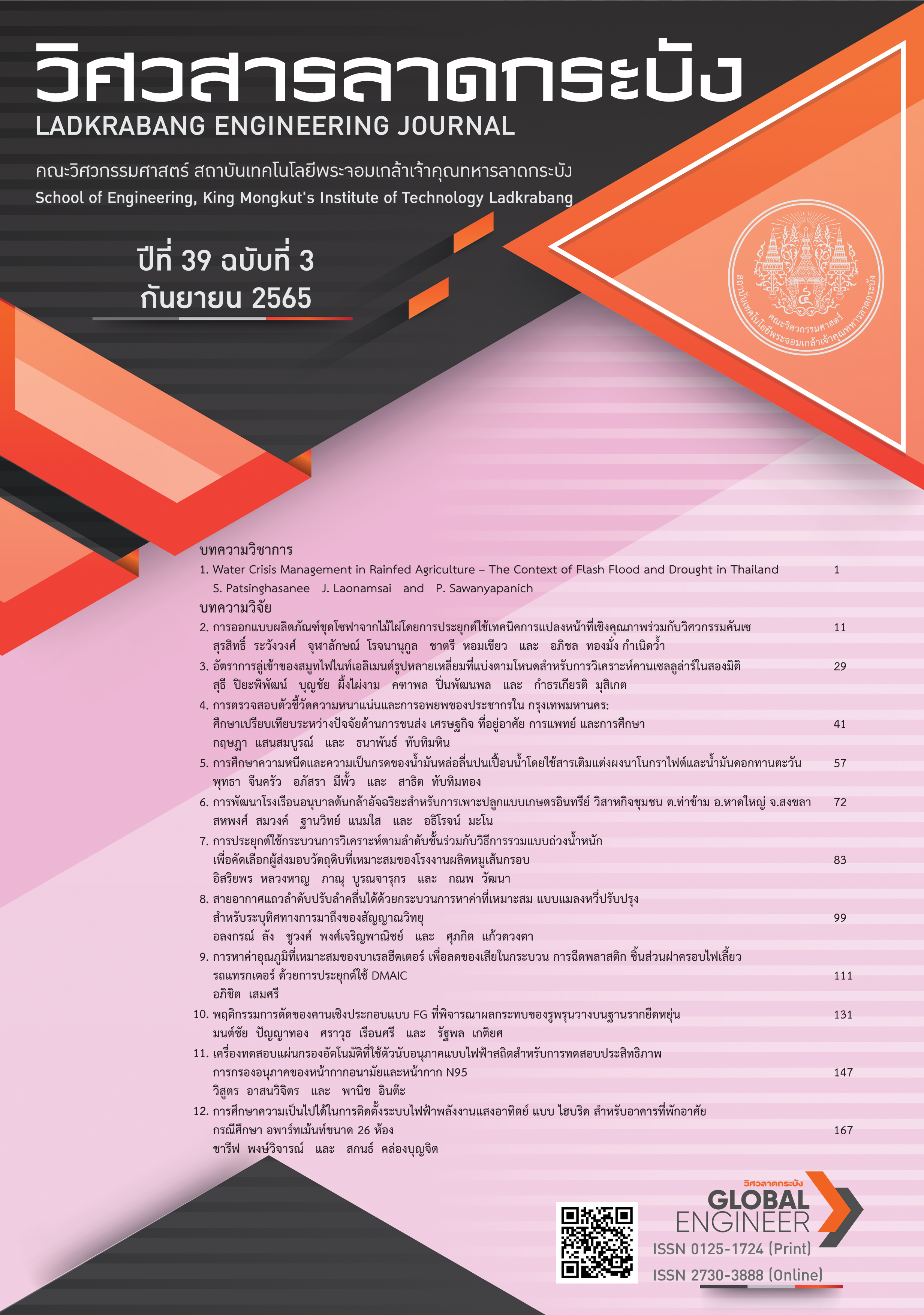Determination of Optimum Temperature of Barrel Heater forReducing Waste in Plastic Injection Molding Process of Tractor Turn Signal Cover Parts using DMAIC Techniques
Keywords:
Injection molding machine, Factorial experiment design, Barrel heater, DMAICAbstract
Abstract
This research aims is to reduce waste in the plastic injection molding process of tractor turn signal cover parts. The researcher used 7QC tools with DMAIC techniques to reducing waste below the target of 1 percent. The experimental research design was a 2k factorial at the 2-level. The research findings pointed out that the main cause of the waste problems was a silver spark accounting for 53.27 percent. Besides, the appropriate values of the factor level for using should be heater 1 temperature is 210°C, heater 2 temperature is 220°C, heater 3 temperature is 225°C, and heater 4 temperature is 246°C. In addition, in a true experiment with the plastic injection molding process of tractor turn signal cover parts, it reduced from 0.80 percent to 0.31 percent. It means that the waste decreased from the original accounting for about 61.25 percent. After the improvement process, the amount of waste was reduced to 0.83 percent from 1.51 percent or reducing of 45.1 percent. When compared to the goals of the company waste less than 1.00 percent found that it can achieve the goals set. After the improvement, waste occurred at 0.83 percent.
References
R. R. Katkhede, A. A Raut and K. Labade, “Defects and Solution of Plastic Parts during Injection Moulding,” International Journal for Scientific Research & Development, vol. 5, no. 9, pp.2321–0613, 2017.
B. S. Reddy, K. Arun, M. C. S. Reddy and B. N. Reddy, “Experimental Investigation and Optimizing of Parameters on Injection Moulding Process with LLDPE Reinforced Fly ash using Taguchi,” International Journal of Advanced Research in Basic Engineering Sciences and Technology (IJARBEST), vol.3, no.38, pp.88–93, 2017, doi: 10.20238/IJARBEST.2017.03s38050013.
S. Patcharaphan, ”Defects of Injection Molded Parts: Causes and Troubleshooting, ”Kasetsart Engineering Journal, vol.69, no. 22, pp. 91 -104, 2009.
D. V. Rosato, D. V. Rosato, M. G. Rosato, ”The Complete Injection Molding process,” in Injection Molding Handbook, 3rded. Kluwer Academic Publishers, Norwell, Massachusetts, 2000, ch.1, sec. 1, pp.1-27.
D. V. Rosato, “Injection Molding,” in Plastics Processing Data Handbook, New York, NY, USA: Van Nostrand Reinhold, 1997. Ch. 2, pp.121–129.
National Metal and Materials Technology Center. “Services.” mtec.or.th http://www.mtec.or.th/index.php?option=com_content&task=view&id=577&Itemid=36 (accessed: Feb. 10, 2021)
W. Techawinyuatham, “Fundamentals of the plastic injection process,” in Plastic injection Engineering, 1st ed. Bangkok, Thailand: Technology promotion (Thai-Japanese), Association, 2010. ch. 1, sec. 1.2, pp. 1–3.
S. Choobthaisong and R. Kanchana, “Reducing Defectives in Plastic Injection Process of Telephone Part By Design of Experiment,” Srinakharinwirot University Engineering Journal (SEJ), vol. 15, no. 3, pp.17–31, 2020.
M. Kittiyakajon, “Application of Analytic Hierarchy Process to Select Quality Improvement for Defect Reduction Projects: A Case Study of Air Tank Manufacturer,” Journal of Engineering RMUTT, vol. 16, no. 2, pp.71–83, 2018.
A. Semsri, A. Suksukont, S. Sisamut and T. Pudtipatkosit, “Quality Control and Loss Reduction in the Front Side Fender Model Assembly Process Using Poka-Yoke Techniques,” RMUTP Research Journal Science & Technology, vol. 15, no. 2, pp.103–117, 2021, doi: 10.14456/jrmutp.2021.25.
R. W. Satty, “The Analytic Hierarchy Process-What it is and how it is used,” Pergamon Journals Ltd, Vol. 9, No. 3-5, pp.161-176, 1987.
O. Siriswasdi, “Study on Appropriate Method of Teflon Production by Design of Experiment Technigue,” M.S. thesis, Dept. Ind Eng., Chulalongkorn Univ., Thailand, 2008.
C. Surasak and K. Rapee, “Product quality improvement in plastic injection process by statistical quality control,” in 15th RSU National Graduate Research Conference, Pathum Thani, Thailand, 2020, pp.2369–2381.
P. Homsri and, C. Kongthana, “Design of Experiment (DOE) to Reduce Waste in Plastic Injection Process of Automotive Parts,” Kasem Bundit Engineering Journal, vol. 3, no. 2, pp. 73–95, 2013
B. Sornin, ” Plastic injection,” in Plastic Technology, 17th ed. Bangkok, Thailand: Technology promotion (Thai-Japanese), Association, 2005. ch.8, sec. 8.2, pp. 146–147.
N. Roth and M. Franchetti, “Process improvement for printing operation through the DMAIC Lean Six Sigma approach: A case study from Northwest Ohio, USA,” International Journal of Lean Six Sigma, vol. 1, no. 2, pp.119–133, 2010, doi: 10.1108/2040146
V. Resonnek and V. Schöppner, “Self-Optimizing Barrel Temperature Setting Control of Single Screw Extruders for Improving the Melt Quality,” in 34th International Conference of the Polymer Processing Society, Taipei, Taiwan, 2019, pp. 1–5, doi:10.1063/1.5088268.
V. Schöppner and V. Resonnek, “Investigation of the barrel temperature profile on the process behavior of single screw extruders and strategies to determine the optimal temperature control,” in 33rd International Conference of the Polymer Processing Society, Cancun Mexico, 2019, pp. 1–5, doi: 10.1063/1.5121650.
Time to Learn about Dynamic Optimization of Extruder Barrel Temperatures, Plastics Technology, May. 2008, [Online]. Available: https://www. ptonline.com/articles/time-to-learn-about-dynamic-optimization-of-extruder-barrel-temperatures
Downloads
Published
How to Cite
Issue
Section
License
Copyright (c) 2022 Faculty of Engineering, King Mongkut’s Institute of Technology Ladkrabang

This work is licensed under a Creative Commons Attribution-NonCommercial-NoDerivatives 4.0 International License.
The published articles are copyrighted by the School of Engineering, King Mongkut's Institute of Technology Ladkrabang.
The statements contained in each article in this academic journal are the personal opinions of each author and are not related to King Mongkut's Institute of Technology Ladkrabang and other faculty members in the institute.
Responsibility for all elements of each article belongs to each author; If there are any mistakes, each author is solely responsible for his own articles.






